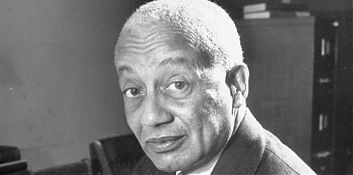Meet the Father of the Harlem Renaissance
By: Charles Molesworth
Posted: February 23, 2013 at 12:08 AM

Author Alain Locke, the first black Rhodes scholar, launched a creative revolution.
(The Root) — Alain Locke was born in 1885 in Philadelphia to freeborn blacks; his mother was a devoted schoolteacher, and his father a civil servant from Washington, D.C. The couple saw to it that Alain was given a most rigorous education, despite his being hampered by rheumatic fever as a child, which left him short of stature and with a weak heart.
After graduating from Central High in Philadelphia, he went on to Harvard. There he garnered a host of awards, the most prestigious being a Rhodes scholarship. He was the first black person to be so honored (and the last until the mid-1960s). He also decided to change his name, from the “Allen” given him at birth to “Alain,” using the French form to announce more prominently his aesthetic sensibility.
With the scholarship in hand, he went to Oxford University for graduate studies in philosophy and on to the University of Berlin before returning to an academic appointment at Howard University in 1912. (He would earn his doctorate from Harvard in 1918 with a thesis on the philosophy of value.) His role at Howard as a professor of philosophy and literature would last for 40 years. Working diligently on issues of race and culture, he soon amassed a long bibliography and also turned his acute attention to artistic matters.
His first measure of national repute came when he edited the anthology The New Negro, first published in 1925, in which he fostered the literary and artistic careers of several important African-American cultural figures. As groundbreaking as The New Negro turned out to be — many credit it with launching the Harlem Renaissance, also known as the New Negro Movement — Locke went on for the next two decades writing essays on an impressive range of subjects.
He reached back into his early research at Howard, where he had formulated a series of lectures he called “Race Contacts and Interracial Relations” (1915), to take up questions of race and racial identity in many different contexts. Readings in the sociology of race cross-fertilized his study of the theories of value and his deep interest in cultural expression. This triumvirate of interests — race, culture and value — shaped what was otherwise a constantly growing and challenging commitment to enlightened change, accompanied by consistent race pride.
Led by the gratitude he felt for his own education, Locke became interested in adult education. He felt strongly that education must be a lifelong undertaking and, in one’s adult years, could usefully focus on one’s own culture and life experience. From this interest grew his publishing project of books designed for adult-education classes. His contributions to the series included The Negro and His Music and Negro Art: Past and Present (both 1936). These monographs — combining Locke’s knowledge of black history and his aesthetic experiences — mapped out a developmental scheme that recorded and assessed the race’s accomplishments over many years.
Locke mastered the literary skill of combining large historical schemes with acutely focused perceptions and judgments by writing year’s-end reviews of books by black authors. These 18 omnibus reviews appeared in Opportunity magazine and, later, Phylon between 1928 and 1952, with only the years during World War II missing.
One of the more important and singular essays by Locke — he referred to it as his only work as an academic philosopher — was titled “Values and Imperatives” (1935). This condensed his Harvard doctoral dissertation into a tightly argued account of how values function in the ways we live and think. By focusing on the functional role of values, Locke rejected any absolutist sense of truth, along with all forms of thought that sought to anchor their claims in unchanging or eternal value systems.
His sense of values was displayed in two special editions of a magazine, Survey Graphic, devoted to social issues. The first, occasioned by the race riot in Harlem in 1935, was “Harlem: Dark Weather Vane” (1936). It delved into the social reality of Harlem, buttressing its arguments with statistics and charts. The second was devoted to World War II and the need to confront racial prejudice on a global scale. Entitled “Color: The Unfinished Business of Democracy” (1942), it included essays from several experts.
Locke’s final volume again gathered essays by various writers. Enthusiastic about the growth of archaeology and anthropology, Locke used contributions from 80 experts in those fields. Called When Peoples Meet (1942), it approached the issues of race and race relations from myriad points of view. Locke contributed the brilliant analytic essays that separated and contextualized the book’s five chapters. He passed away in New York City in 1954.
Charles Molesworth is professor emeritus of English at Queens College, City University of New York. In 2012 he edited the essays of Alain Locke (Oxford University Press), and published And Bid Him Sing: A Biography of Countée Cullen.